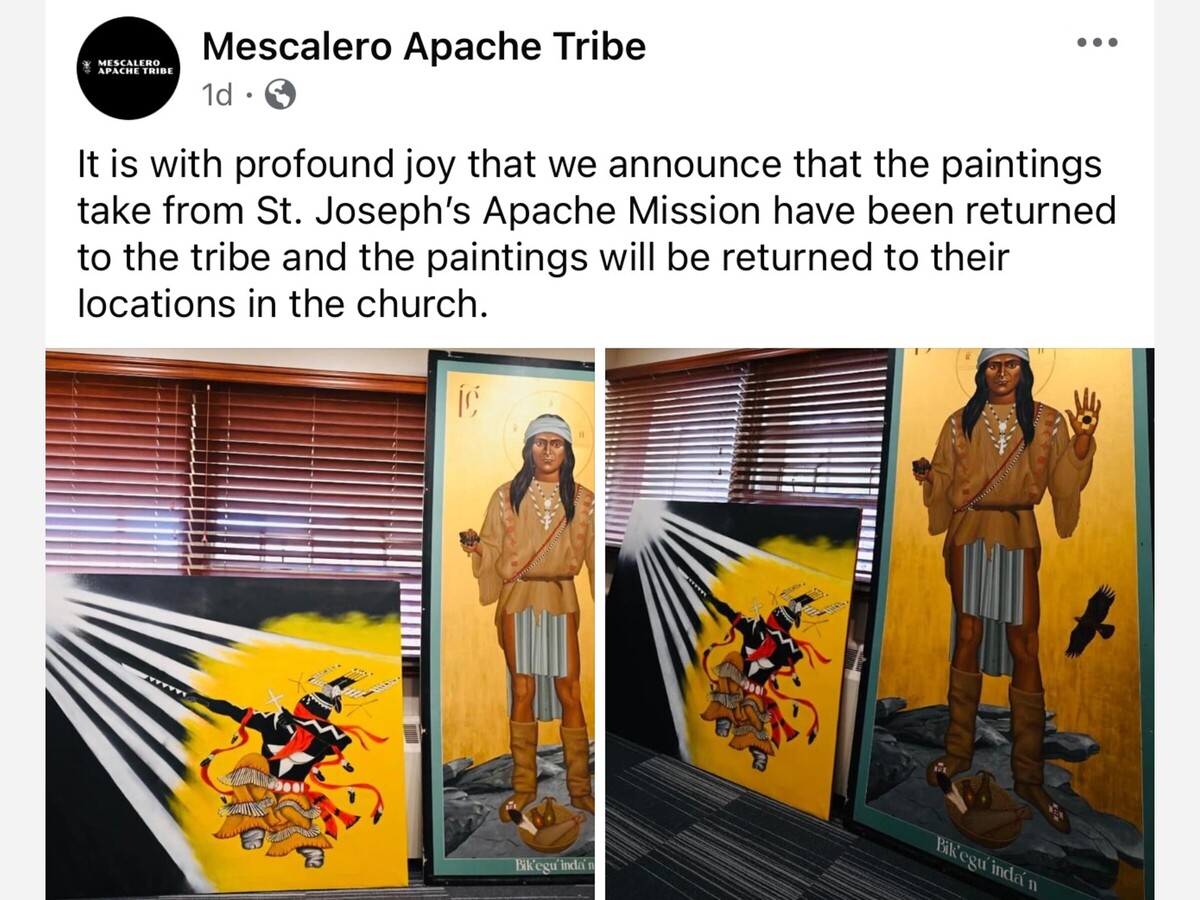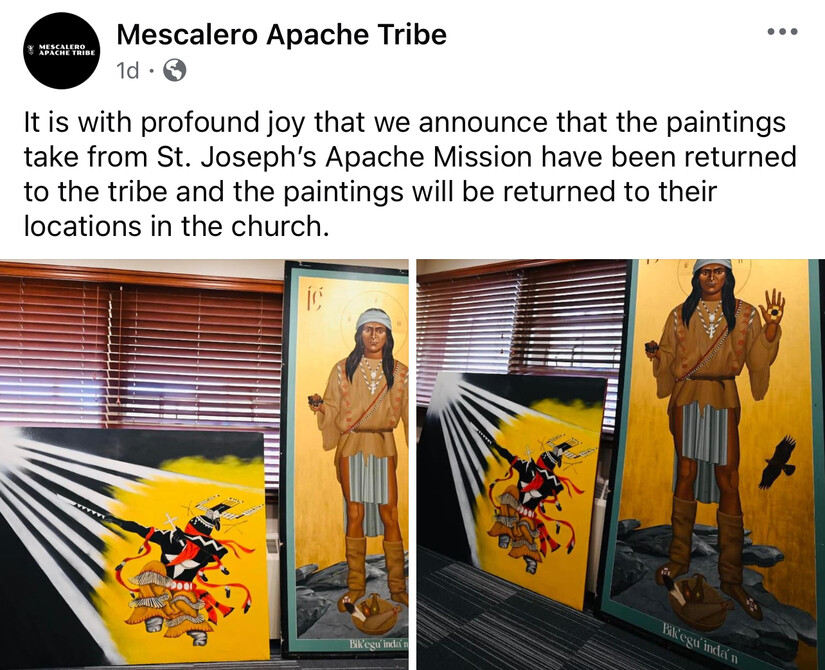Image


AlamogordoTownNews.org and KALHRadio.org was the first legitimate media source to break the story of the heist of the sacred artwork created for the benefit of the Mescalero Apache people tat was hosted at the St. Joseph Apache Mission on order by Fr. Chudy and supported by the Diocese of Las Cruces administration including the Bishop, the Alamogordo Knights of Columbus. Following our breaking the story and persistent pursuit of the truth via a variety of stories and interviews other media soon jumped on board to include national press and others, this is why local news organizations matter.
As a result of that coverage that went viral due to the activism of Tribal and church members outraged, at the improper actions of the church leaders, and their lack of sensitivity towards the tribes customs and beliefs social media blew up, hundreds of phone calls and protests letters were sent to the church leadership and they yielded and returned the artwork to the Mescalero Apache Tribe via an announcement from the tribe…

Alamogordo Town News reported via an interview from Anthony Lucero concerning the incident at
https://youtu.be/WIt5E68mw2Y?si=ZqZphmAY7MKCxg_7
The Native American version of an image of Jesus Christ by an acclaimed iconographer was removed from the Mescalero New Mexico church by order of the priest, days after the U.S. bishops approved a pastoral framework for Indigenous ministry.
Painted by Franciscan Friar Robert Lentz, “Apache Christ” is an 8-foot icon depicting Jesus as a Mescalero holy man, with the inscription in Apache “giver of life.” Since 1989 it had hung behind the altar of the church under a crucifix.
This image and a painting of Apache dancers by the late Apache artist Gervase Peso were taken down from the interior walls of St. Joseph Apache Mission in Mescalero, N.M., sometime during the evening of June 26.
The icon’s detailed frame, which had been crafted by New Mexico-based wood sculptor Roberto Lavadie, had been disassembled and left in a locked storage area of the church to which only the pastor, Father Peter Chudy Sixtus Simeon-Aguinam, had access.
In response to criticism of the Knights of Columbus and their involvement a spokesperson issues the following in a statement to OSV News, Anthony D. Salazar, state deputy of the New Mexico State Council of the Knights of Columbus, that regarding any Knights of Columbus who may have been involved in the icon’s removal, “these gentlemen were acting on their own behalf” and “not … in the capacity of a Knight of Columbus. As an organization, the Knights of Columbus — the largest Catholic fraternal organization in the world — has a Native Solidarity Initiative and is involved in promoting awareness about Native Catholics and their traditions through their “Enduring Faith” documentary and their support for the canonization of Nicholas Black Elk, a Lakota holy man and Catholic catechist. The Knights’ Supreme Secretary Patrick Mason is a member of the Osage Nation.”
Mescalero Tribal Police told AlamogordoTownNews.org that they had “taken a report” about the removal of the painting on June 27, and that the matter is under investigation.
On a webpage for the parish, Gabriella who interfaced with us via instant messenger had posted an audio recording of a 12-plus minute June 27 phone call she had with Deacon Munson, in which Brillante said she had “just (been) made aware that the ‘Apache Christ’ has been stolen.”
“Not stolen, just removed,” replied Deacon Munson, who advised Brillante that the pastor, “the Knights of Columbus” and the diocesan property risk manager had been involved in the change.
When Brillante asked where the icon was, the deacon replied, “It’s not germane.”
Brillante countered that “if (the icon) was taken off the reservation, off of federal land, without permission then that’s called theft,” and that the icon had been “given to the parishioners of the Mescalero Apache Tribe.”
Brother Lentz who had created the artwork had previously stated as reported by AlamogordoTownNews.org that the artwork was commissioned in collaboration with the Mescalero Apache people for the people and not owned by the church.
In 1992 this icon was displayed in the Smithsonian museum as an example of art reflecting indigenous spirituality. The artist, Robert Lentz, OFM is a master at his craft, and he researches his subjects intensely before painting them. In this case, he sat at the feet of an Apache elder who instructed him in the spiritual ways of his peoplevideo to Facebook describing the creation of the icon, which included substantial consultation and collaboration with the Apache community — said in a statement posted on his behalf on X, formerly Twitter, that he “GAVE the icon to the Mescalero people, who then commissioned an elaborated hand-carved frame for it.
“What has happened in the past few days reminds me of something from the nineteenth century, when it was not uncommon in New Mexico or Arizona for a posse of white men to sneak up on an Indian village in the dark of night for an ambush,” wrote Brother Lentz in the statement. “The ‘posse’ in this case was made up of men from a conservative Catholic organization in a military town, on the other side of a mountain range, 30 miles from Mescalero. That they were led by the priest currently assigned to Mescalero only adds to the shame.”
Brother Lentz, who designed the “Saints of the Americas” altar reredos in Sante Fe’s Cathedral Basilica of St. Francis of Assisi, added that “from 1990 to 2019, bishops of Las Cruces visited the church in Mescalero and gave their tacit approval to the icon. Had it violated Roman Catholic doctrine, they would have asked for its removal. They did not.”
The recent incident involving “Apache Christ” follows in the wake of the U.S. Catholic bishops’ overwhelming vote June 14 to approve a new pastoral framework for Indigenous Catholic ministry called “Keeping Christ’s Sacred Promise” during their spring general assembly in Louisville, Kentucky.
“Many Indigenous Catholics have felt a sense of abandonment in their relationship with church leaders due to a lack of understanding of their unique cultural needs,” says the introduction of the pastoral framework. “We apologize for the failure to nurture, strengthen, honor, recognize, and appreciate those entrusted to our pastoral care.”
The five-part framework focuses on calls for healing, mission, reconciliation, holiness and transformation in ministry to the nation’s Indigenous Catholics, whose “journey … in the United States of America has been marked by moments of great joy but also of profound sorrow,” the document states.
Nearly two years earlier, in July 2022, Pope Francis made a penitential pilgrimage to Canada in which he affirmed the importance of the Catholic faith expressing itself through Indigenous cultures, and apologized for the ways in which “Catholics contributed to policies of assimilation and enfranchisement that inculcated a sense of inferiority, robbing communities and individuals of their cultural and spiritual identity, severing their roots and fostering prejudicial and discriminatory attitudes.” Pointing to the various Indigenous Catholic inculturated art and symbols at Sacred Heart Church in Edmonton, Alberta, he said, “This liturgical symbolism reminds me of the magnificent words spoken by St. John Paul II in this country: ‘Christ animates the very center of all culture. Thus, not only is Christianity relevant to the Indian people, but Christ, in the members of his Body, is himself Indian.'”